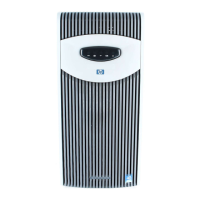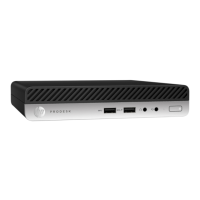Hardware options installation 57
Memory configurations
To optimize server availability, the server supports the following AMP modes:
• Advanced ECC—Provides up to 4-bit error correction and enhanced performance over Lockstep mode.
This mode is the default option for this server.
• Online spare memory—Provides protection against failing or degraded DIMMs. Certain memory is
reserved as spare, and automatic failover to spare memory occurs when the system detects a DIMM that
is degrading. This feature enables DIMMs that have a higher probability of receiving an uncorrectable
memory error (which would result in system downtime) to be removed from operation.
Advanced Memory Protection options are configured in RBSU. If the requested AMP mode is not supported
by the installed DIMM configuration, the server boots in Advanced ECC mode. For more information, see
"HP ROM-Based Setup Utility (on page 117)."
The server also can operate in independent channel mode or combined channel mode (lockstep). When
running in lockstep mode, you gain reliability in one of two ways:
• If running with UDIMMs (built with x8 DRAM devices), the system can survive a complete DRAM failure
(SDDC). In independent channel mode, this failure would be an uncorrectable error.
• If running with RDIMM (built with x4 DRAM devices), the system can survive the complete failure of two
DRAM devices (DDDC). Running in independent mode, the server can only survive the complete failure
of a single DRAM device (SDDC).
Maximum capacity
DIMM type DIMM rank One processor Two processors
RDIMM
RDIMM
Dual-rank 2 GB 8 GB
For the latest memory configuration information, see the QuickSpecs on the HP website
(http://www.hp.com).
General DIMM slot population guidelines
Observe the following guidelines for all AMP modes:
• Install DIMMs only if the corresponding processor is installed.
• When two processors are installed, balance the DIMMs across the two processors.
• White DIMM slots denote the first slot of a channel (Ch 1-A, Ch 2-B, Ch 3-C).
• Do not mix UDIMMs or RDIMMs.
• When two processors are installed, install the DIMMs in sequential alphabetical order balanced
between the two processors: P1-A, P2-A, P1-B, P2-B, P1-C, P2-C, and so on.
For detailed memory configuration rules and guidelines, use the Online DDR3 Memory Configuration Tool
on the HP website (http://www.hp.com/go/ddr3memory-configurator).
DIMM speeds are supported as indicated in the following table.
Populated slots
(per channel)
Rank Speeds supported (MT/s)
1
Single or dual rank 1333, 1600

